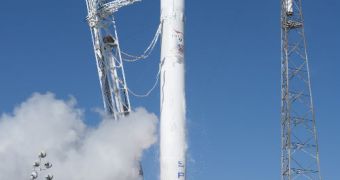Two private space companies signed an agreement yesterday, February 6, that draws the major guidelines for a new cooperative program. The corporations are planning to rely on each other to launch a robot to the Moon by as soon as December 2013.
Astrobotic Technology is the company that will develop and construct the robotic explorer, whose goal will be to search for water-ice on the surface of Earth's natural satellite. While doing so, the robot will also send a 3D video feed of its adventures.
While the corporation has the necessary expertise to create the explorer itself, it cannot really venture into the field of rocket-building. This is where Hawthorne, California-based Space Exploration Technologies Corporation (SpaceX) comes in.
The agreement the two signed on Sunday states that SpaceX needs to contribute to the upcoming lunar mission with one of its Falcon 9 medium-lift delivery systems. This is how Astrobotic plans to take its robot, as well as other payloads, to the surface of the Moon.
“The mission is the first of a serial campaign. Astrobotic's missions will pursue new resources, deliver rich experiences, serve new customers and open new markets,” Dr. William Whittaker explains.
“Spurred further by incentives, contracts, and the Google Lunar X-Prize, this is a perfect storm for new exploration,” adds the expert, who is the chairman of Astrobotic Technology.
Whittaker is also the founder of the Carnegie Mellon University (CMU) Field Robotics Center. The private companies will use numerous technologies pioneered at the university during the mission.
The plan is to launch the Falcon 9 carrying the robot into Earth's orbit, from whence the spacecraft will be inserted on a lunar-bound trajectory. The trip will last for about four days, and will be made by the upper stages of the Falcon 9 and the robotic explorer, SpaceRef reports.
Once at the Moon, the spacecraft will land softly on the natural satellite's surface. This is where CMU-developed technologies will play a critically-important role. After landing, the robot will spend three months performing science operations.
“The Moon has economic and scientific treasures that went undiscovered during the Apollo era, and our robot explorers will spearhead this new lunar frontier,” explains Astrobotic president David Gump.
“The initial mission will bank up to $24 million in Google's Lunar X-Prize, Florida's $2 million launch bonus, and NASA's $10 million landing contract while delivering 240 pounds of payload for space agencies and corporate marketers,” he adds.
Officials at the private company explain that they selected the Falcon 9 delivery system because it managed two outstanding performances last year, in June and December, during critical SpaceX tests.

 14 DAY TRIAL //
14 DAY TRIAL //